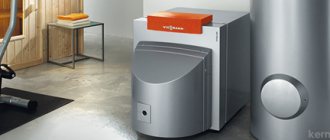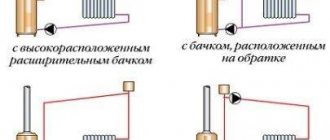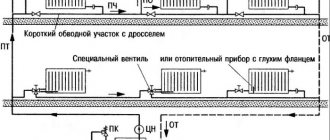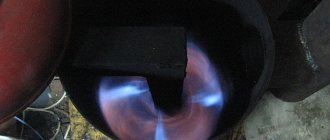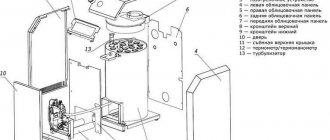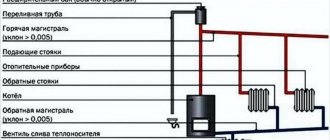Independent (closed) heating system
Currently, when installing new boiler houses, an independent connection scheme for the heating system has become more often used.
It contains a main and an additional circulation circuit, hydraulically separated by a heat exchanger. That is, the coolant from the boiler room or thermal power plant goes to the central heating point, where it enters the heat exchanger, this is the main circuit. The additional circuit is the heating system of the house; the coolant in it circulates through the same heat exchanger, receiving heat from the network water from the boiler room. The operating diagram of the independent system is shown in the figure: For reference. Previously, bulky shell-and-tube heat exchangers were installed in such systems, which took up a lot of space. This was the main difficulty, but with the advent of high-speed plate heat exchangers, this problem ceased to exist.
But what about the centralized supply of hot water, because now you can’t take it from the mains, the temperature there is too high (from 105 to 150 ºС)? It's simple: an independent connection diagram allows the installation of any number of plate heat exchangers connected to the main pipelines. One will provide heat to the heating system of the house, and the second can prepare water for household needs. How this is implemented is shown in the diagram:
To ensure that hot water always flows at the same temperature, the DHW circuit is made closed with automatic replenishment in the return pipeline. In apartment buildings, the DHW circulation return line can be seen in the bathroom; heated towel rails are connected to it.
It is obvious that operating an independent heating system has many advantages:
- the home heating circuit does not depend on the quality of the external coolant, the condition of the main networks and pressure drops. The entire load falls on the plate heat exchanger;
- it is possible to regulate the temperature in the rooms using thermostatic valves;
- the coolant in a small circuit can be filtered and cleaned of salts, the main thing is that the pipes are in good condition;
- The hot water supply system will contain drinking quality water entering the house through the water main.
However, due to dirty, low-quality coolant in the central network, periodic flushing of the independent heating system, or more precisely, the plate heat exchanger, will be required. Fortunately, this is not so difficult to do. Another disadvantage is the higher costs of purchasing equipment, namely: heat exchangers, circulation pumps and shut-off and control valves. But a closed system is more reliable and safer than an open one, it better meets modern requirements and is better adapted to new equipment.
Independent organization of the heating system
Boiler room arrangement
A good and high-quality heating option can be made with your own hands, if you take into account the costs of design, equipment purchases and the complexity of the organization. The best option for a private home would be a closed type of communications with a circulation pump and tanks. Its creation is carried out like this:
- Communication calculations. Ordered from a design company or produced using an online calculator.
- Coordination of the project, obtaining permits and technical conditions.
- Purchase of equipment. You will need a heating boiler, a pump, pipes, an expansion tank, radiators (circuits if you plan to have a heated floor), air vents, shut-off devices, and automatic controllers.
- Boiler installation and boiler room equipment. High-quality ventilation is organized in the room and a chimney is installed. The walls, floor and ceiling surfaces are sheathed with fire-resistant materials.
- Installation of a circulation pump, distribution manifold and measuring instruments.
- Pipeline connections to battery locations.
- Installation of radiators.
- Pressure testing of the system. The first launch is carried out in the presence of specialists.
The collector circuit is difficult to install and is expensive, but by adjusting the circuits, the living conditions in the room will be comfortable.
There are several differences between open and closed heat supply communications. It is worth choosing a heating system depending on the conditions and installation location. It is easy to organize an open highway yourself. Specialists must create a closed system.
Open heating systems
Open heat supply systems are characterized by the fact that hot water is collected for consumer needs directly from the heating network, and it can be either full or partial. The remaining hot water in the system continues to be used for heating or ventilation.
With this method, the water consumption in the heating network is compensated by an additional amount of water that is supplied to the heating network. The advantage of an open heating system lies in its economic benefits. During the Soviet period, almost 50% of all heating systems were open type.
At the same time, one cannot discount the fact that such a heat supply system also has a number of significant disadvantages. First of all, this is the low sanitary and hygienic quality of water. Heating appliances and pipeline networks give the water a specific smell and color, various foreign impurities appear, as well as bacteria. Various methods are usually used to purify water in an open system, but their use reduces the economic effect.
An open heat supply system can be dependent by the method of connection to heating networks, i.e. connect through elevators and pumps, or connect according to an independent scheme - through heat exchangers. Let's look at this in more detail.
Dependent heat supply systems
Dependent heat supply systems are systems in which the coolant through a pipeline enters directly into the consumer’s heating system. There are no intermediate heat exchangers, heating points or hydraulic insulation. There is no doubt that such a connection scheme is understandable and structurally simple. It is easy to maintain and does not require any additional equipment, for example, circulation pumps, automatic regulation and control devices, heat exchangers, etc. Most often, this system attracts with its, at first glance, cost-effectiveness.
However, it has a significant drawback, namely, the inability to regulate heat supply at the beginning and end of the heating season, when excess heat appears. This not only affects the comfort of the consumer, but also leads to heat loss, which reduces its initially apparent efficiency.
When energy saving issues become relevant, methods for transitioning a dependent heat supply system to an independent one are developed and actively implemented, this allows heat savings of about 10-40% per year.
Independent heating systems
Independent heat supply systems are systems in which the heating equipment of consumers is hydraulically isolated from the heat producer, and additional heat exchangers of central heating points are used to supply heat to consumers.
An independent heat supply system has a number of undeniable advantages. This:
- the ability to regulate the amount of heat delivered to the consumer by regulating the secondary coolant;
- its higher reliability;
- energy-saving effect, with such a system heat savings are 10-40%;
- it becomes possible to improve the operational and technical qualities of the coolant, which significantly increases the protection of boiler installations from contamination.
Thanks to these advantages, independent heat supply systems have become actively used in large cities, where heating networks are quite extensive and there is a large variation in heat loads.
Currently, technologies for reconstructing dependent systems into independent ones have been developed and are being successfully implemented. Despite significant investment, this ultimately has its effect. Naturally, an independent open system is more expensive, but it significantly improves the quality of water compared to a dependent one.
Features of open and closed systems
Open heating system
To heat a house, a closed type of coolant flow structure is used, including a boiler, radiators and pipes. The system works on the principle of heating water to a certain temperature in special equipment, moving through a pipeline to radiators and further releasing heat to warm up the rooms. After cooling, the liquid is returned back to the heating device, forming a repeating cycle.
Open system
To understand what an open heating system is, it is worth using the multi-apartment building type as an example. This type of heating involves the use of a special storage tank, which is actively functioning in most multi-story buildings. On the roof of the high-rise building there is an expansion tank to collect excess water. The tank is not sealed, which allows vapors to escape into the external environment.
The open version is installed without a circulation pump. The coolant is directed through the pipes naturally. After heating the boiler to a certain temperature, the pressure increases, and the hot water, rising to the top, pushes out the cold water. The volume of water also increases when heated, so the excess goes into the expansion tank. The cooled coolant is again sent to the system.
Closed type of communications
Closed system
A closed heat supply scheme involves a pump that provokes the movement of water through the pipes. Forced circulation is also realized using pipes, a boiler, radiators, and an expansion tank. The metal tank is sealed, consists of two rolled parts, and has the following contents:
- internal rubber diaphragm – heat-resistant membrane;
- gas in a small volume - factory nitrogen or air accumulated in the line.
The membrane divides the container into two compartments - for collecting excess heated water and for storing air.
The coolant moves through the system, but when it heats up, the reservoir valve takes away the excess. They enter the expansion tank, penetrate the membrane and are pushed back with the help of gas. After cooling, the circulation pump pumps water back into the system, while simultaneously monitoring pressure levels. In this way, the coolant is deaerated.
Main differences
The difference between an open and closed heating system is as follows:
- Location of the expansion tank. In the open - the top floor of a private house or the roof of a high-rise building. The closed tank can be placed anywhere.
- Isolation from air access. Unlike an open one, a closed highway is protected from air currents. Additional pressure at the top points prevents airing of the batteries.
- Complexity of arrangement. An open system will differ from a closed system in the type of pipeline. Products of large diameter are mounted taking into account the location of radiators, air slope, the presence of turns and rises.
- Organization costs. Closed heat and water supply requires financial costs for the purchase of thick-walled pipes. You can save on an open system by using small-diameter lines.
- Noise level. The forced type of circulation in a closed line involves the use of a pump. When installed correctly, the equipment will not make noise.
Creating heating for a closed house will save from 10 to 40% of energy resources per year.
Features of work
The transition to a closed system requires financial investments, but these investments pay off in the future. The decision to make the transition is made by the overwhelming majority of companies providing heat supply services to the population. The organization of heat supply work is constructed in various ways; there may or may not be dependence on electrical energy.
A steel or cast iron boiler running on solid fuel can be used as a heat generator. The constant loading of flammable material becomes a significant disadvantage, however, compared to the temperature loss during a power outage, this does not seem to be a serious problem.
To ensure independent heating in a private home, the following technical solutions will help:
- bunker and transport belt (supply of firewood or sawdust, minus - the belt requires electricity to operate);
- pyrolysis boiler (solid fuel is burned at the first stage, and the resulting gas is burned at the second stage);
- top combustion boiler (capable of operating for about 5 days on one burner, a fan is required for operation).
It is impossible to automate the heating system using these methods without the use of electrical energy. An alternative is gas boilers equipped with a mechanical thermostat. If the temperature is lost, the gas supply and heating of the coolant are resumed.
The advantage of an independent heating scheme over an open one is clear, but there are nuances in organizing such a system. Options for creating heat supply using a closed model are characterized by diversity. There is no universal solution; for each specific case, special approaches are practiced; consultations with professionals will help you choose the appropriate option.
Types of heating according to the method of coolant circulation
Effective heat transfer into the room in water heating systems directly depends on the speed of coolant movement in the internal heating circuit.
For small heated objects, the required speed of hot water movement can be achieved using natural circulation, and for larger objects with complex multi-level heating circuits, the coolant speed is achieved by using an electric centrifugal pump.
Natural circulation
It is more correct to call these systems gravitational. Since the heated water rises through a vertical pipe, under the influence of the gravitational effect caused by the temperature difference of the coolant and, consequently, the different density of the liquid creating pressure. This pipe is considered a supply riser.
Then the coolant moves through the supply pipeline to the heating devices. In which heat is transferred to the surrounding air and, thanks to convection, spreads throughout the room. The water cools down and returns to the boiler through the return pipeline.
Its density increases, creating a pressure that displaces heated water from the boiler into the supply pipeline for the next heating cycle.
Forced circulation
These are modern, efficient heating systems capable of heating a house of any number of floors and area with multi-level building heating circuits, operating with different heating modes, for example, a traditional radiator system with a “warm floor” option. The piping can be done with small-diameter pipes, which are placed at any angle and in any place based on the adopted design and dimensions of the rooms.
The advantage of these systems is explained by a high level of regulation, capable of providing an individual heating mode for each room in the context of days and heating months.
There is only one drawback of this heating option - it is energy-dependent, therefore, to ensure uninterrupted operation, it is necessary to provide an emergency source of electrical energy, which the boiler unit will most likely need.
Which heating system is better
This question will primarily depend on the budget that the owner is able to allocate for organizing the heating system. Equally important is the availability of fuel, the climatic region of construction and the state of thermal insulation of the walls of the house.
If we analyze the heat supply system for the central region of Russia for a multi-level residential building from 200 to 300 m2, when the owner is not burdened with funds, then the most promising heat supply options will be distributed as follows:
- Heat pump.
- Gas boilers.
- Solid fuel boilers.
- Warm floor.
- Electric boilers.
In any case, before choosing a heating system in a private house, the owner will need to contact specialists so that they can evaluate all the thermally significant factors of the heating object in order to ensure long-term operation of heating network equipment with low cost of thermal energy.
However, according to most technical and economic indicators, heat pumps and geothermal installations are the best direction in the development of heating systems.
Types of circulation in heating circuits
To deliver heat to the batteries, you need to move the coolant heated by the boiler. Natural circulation is used in the heating system and forced movement of water using a circulation pump. Natural circulation is used in simple heating systems; it requires a minimum of equipment with minimal installation and operating costs.
To implement this method of moving the coolant, a change in the physical properties of water when heated is used. The speed of movement depends on the temperature difference and on the magnitude of hydraulic resistance, which is reduced by increasing the diameter of the pipes.
Open heating circuit
An open gravity heating system with natural circulation has undoubted advantages.
Advantages of open natural coolant circulation:
- simplicity and low installation costs;
- efficiency;
- easily converted into a system with forced circulation; the circulation pump is usually installed in the “return”.
Therefore, the heating system for a one-story house with natural circulation is very popular and is successfully used. The main disadvantages of such heating are high inertia. In addition, the presence of an open expansion tank determines the answer to the question - is it possible to pour antifreeze into the heating system of a house. You can fill it, but it will constantly evaporate, which will make the operation of the system unprofitable.
Closed heating circuit
The coolant in a closed heating system has no contact with atmospheric air. To compensate for thermal expansion, sealed membrane expansion tanks are installed. A closed heating system can have any design; it is equipped with a circulation pump to move the coolant. The absence of contact of the coolant with air significantly increases the service life of pipes and heating circuit equipment.
If during installation the slope of the pipes is provided, then in the absence of mains voltage and the bypass is switched, natural circulation will occur in the closed heating system of the house. Of course, the efficiency of the system will drop, but the heating will be operational and will continue to heat the home.
The main advantages of a closed heating system:
- the use of a sealed expansion tank eliminates the evaporation of liquid; in closed systems, antifreeze can be used as a coolant;
- the absence of contact between water and air protects circuit elements from internal corrosion;
- a closed heating circuit has low inertia and high efficiency;
- the use of a circulation pump allows you to reduce the diameter of the pipes and reduce the cost of purchasing them;
- for heated floors and complex branched circuits, an additional pump is installed in the heating system, which will ensure their efficient operation.
The influence of air on the operation of the heating circuit
When, for one reason or another, air appears in the heating system, the normal operation of the system is disrupted. Circulation worsens or stops altogether, with all the ensuing consequences. In such cases, experts say that the heating system is airy and measures must be taken to remove air pockets.
The presence of air in the circuit can cause unpleasant phenomena:
- noise when water moves through radiators and vibration, which causes loosening of screw connections and sometimes destruction of welding points;
- in remote utility rooms, lack of circulation can lead to defrosting of the system;
- slight airing causes a decrease in operating efficiency and excessive fuel consumption;
- air causes corrosion of metal pipes and housings from the inside, which sharply reduces the service life of the equipment.
To successfully remove air from the circuit, vents are used in the heating system, which can be manual or automatic. Of the manual air vents, the most famous is the Mayevsky valve. It is installed at the end of the battery and with its help the accumulated air is released. An automatic air vent removes air from the system during operation.
Air vents are installed in critical places, such as pipe turns and the highest points of heating systems.
Dependent heat supply scheme
If you imagine the elevator unit of a residential building (you can see what it looks like in the photo), then it is arranged as follows:
- the elevator is separated from the heating main by inlet valves;
- behind them, at the supply and return points, valves or gate valves are located. Hot water supply is connected through them from the supply or return pipelines. Often in modern elevators there are two taps on the supply and return lines, which are separated by a retaining washer. Their purpose is to ensure constant circulation of hot water;
- after inserting the elements to provide DHW, there is a nozzle with a chamber where mixing is carried out. The flow of hotter liquid coming from the direct pipeline under high pressure heats up part of the water in the return and is sent for recirculation;
- house valves shut off the heating system of the building - they are open in winter and closed in the warm season.
Dependent and independent heating systems differ in that in the first version, water enters the hot water supply and heating systems directly from the heating main.
Why are they called closed or closed?
The pump creates a slight increased pressure in front of the fluid and a vacuum behind the impeller. If the system has an open expansion tank and atmospheric pressure, then it is possible that the liquid will simply pour out of it or other hydraulic troubles will occur... For normal operation, there must be a slight increased pressure in the system, the norm is 1.5 - 2.0 atm for an unheated state .
To maintain increased pressure, the system is closed and a closed-type membrane expansion tank is used, one half of which is initially pumped with air to a pressure of 1.3 - 1.4 atm. Now, during thermal expansion, the liquid does not escape “into the pan”, but its excess part compresses the air in the tank and the pressure in the system increases slightly. The heating system turns out to be closed (closed).
We recommend: Thermofor stoves for baths and saunas: rating of popular models
Comparison of solutions
The dependent heating connection scheme has, in essence, only one advantage, but a very important one - low cost of implementation. You can assemble an elevator unit for a small cottage with your own hands from consumer-grade shut-off valves
The only thing noticeable against the background of wiring batteries around the house will be the cost of manufacturing the nozzle - the only exclusive one made, the diameter of which determines the thermal power of the elevator.
What are the assets of an independent scheme?
Incomparably more flexible adjustment of the coolant temperature for the heating system. It is enough just to reduce the flow of coolant through the heat exchanger - and the house will become colder.
- The practical consequence of flexible adjustment of heating to the needs of the home is efficiency. Relative to the dependent system, it is estimated at 10-40 percent.
- Finally, the main thing: in a dependent system we are forced to use water with a lot of pollution. It carries sand, scale and a lot of mineral salts.
There is no talk of using water as drinking water; moreover, in some regions it is undesirable to even wash with hot tap water. An independent circuit makes it possible to use purified water or even non-freezing coolants as a coolant.
It is not a problem to heat drinking water for DHW needs.
What are hydronic heating systems?
Such networks are considered the best option for heating residential buildings. In both private houses and urban high-rise buildings, in the vast majority of cases, water heating systems are installed.
In industrial premises, such networks are also used quite often. The only thing is that they cannot be installed in buildings intended for storing chemicals, for example, such as:
- potassium;
- calcium carbide;
- sodium:
- lithium and some others.
That is, such heating networks are not assembled where substances that can ignite upon contact with water are stored or used in the production process.
Boilers are most often used as heating equipment in systems of this type. Water in networks of this type circulates through pipes stretched throughout the premises. Heating radiators installed in rooms or workshops are directly responsible for heating the building.
The main advantage of water systems is that the batteries and pipes in this case do not heat up too much. Consequently, the possibility of burns due to accidental contact with them is excluded. Also, dust does not burn or cake on the batteries and mains of such networks.
Independent heating system and its types
An independent heating system is divided, in turn, into two subtypes according to the implementation of the method of circulating energy in pipelines:
- Gravitational, otherwise called non-volatile. The liquid moves through the pipes due to the different densities of the cold and heated substances. Therefore, the heated carrier coming from the heat exchanger tends upward due to its lower specific gravity, while the cold carrier, on the contrary, settles at the lowest points of the heating main. This feature imposes several strict requirements for full functionality:
- The heat exchange device or hot water boiler, if the heating is autonomous, must be placed at the lowest point of the building. If radiators are also installed on this floor, you will have to install a pit below floor level.
- All horizontally laid pipelines should be mounted at a slope of two to three degrees in the direction of movement of the coolant in the pipe. That is, the feed will have a positive angle relative to the general vector, and the return will have a negative angle.
- To minimize the negative impact of hydraulic resistance, the bore diameter of the pipes must be large. For a two-story cottage with five to seven heated rooms, a diameter of 35 millimeters will be sufficient. The principle of more is better is in full effect here.
- Circulating or energy dependent. The coolants of the centralized supply system and the heat distribution hydraulics have no physical contact with each other. Heat transfer from one to another occurs in the so-called heat exchanger, which is a tank in which there are tubes with liquid circulating through them. That is, an independent connection of the heating system makes it possible to flexibly adjust the temperature regime of heated structures, simplify the modification and expansion of the network and save on heating costs. There are also features:
- The cost of construction significantly exceeds the cost of the first method.
- Increased demands are placed on the quality of secondary circuit coolants.
- There is almost always a need for a continuous power supply to ensure the circulation process.
Independent system
An independent heating system integration scheme is an innovative solution for heating a cottage. The coolant from the source first enters the central heating point. After this, it enters the main circuit: the heat exchanger. The coolant, circulating in it, receives heat from network water obtained from the boiler room; all this happens in the heating system of the house, which is also called an additional circuit.
To supply hot water, special heat exchangers called plate heat exchangers are installed. Their number is not limited, usually from 2 to 5. They are connected to the mains, each heat exchanger plays a specific role: one works to heat the rooms, the second ensures the availability of warm water for household work.
The main advantages of an independent heating system:
- There is no dependence on the quality of external characteristics, such as the quality of the coolant and pipelines. There are no problems due to pressure drops; the plate heat exchanger takes care of all the work;
- it becomes possible to install thermostatic valves and regulate the temperature in the house;
- the coolant in the additional circuit can be cleaned;
- the water that comes through the pipeline is potable;
The disadvantages of an independent heating system include the rather high cost of such a system.
Types of independent systems
Two-pipe is more suitable for multi-story buildings. There are horizontal and vertical wiring, a supply line, and, accordingly, a return line. The advantage is the same heating of the batteries, regardless of the distance to the boiler. The supply line has a single riser to which all heating devices are connected.
For a vertical independent scheme, radiators on each floor are connected to the riser independently. Each radiator is connected to 2 pipes: direct flow and return. Such a system is financially expensive, but allows you to regulate the temperature of each room. Horizontal risers are installed in several places around the house and batteries are connected to them. Only specialists can carry out competent installation.
The beam system is laid under the floor so as not to disfigure the interior of the rooms. Metal-plastic pipes are laid from the distribution manifold and hidden under the surface. The system allows you to set a certain temperature in each room, but at the same time the costs of maintenance and installation increase significantly. You can also turn off any radiator without turning off the entire heating system. All rooms are heated evenly; the likelihood that water or other coolant will leak out of the pipes is close to zero due to the lack of joints.
Schematic difference between two-pipe and radiant heating circuits
Warm floors are a popular heating system for a private home. Pipes made of metal-plastic or other suitable material are distributed from the collector. Warm liquid moves along the heating circuit, giving energy to the screed, thereby warming it up. When the water cools, it moves to the boiler, where it is heated again, and then the process is repeated in a circle. There are special limiters built into the floor that prevent water from crossing a certain temperature threshold. At the same time, heating costs are reduced, but you will have to wait a very long time for the process of installing a floor heating system and spend a lot of money on it.
Heating network pipes
Currently, domestic ones are in disrepair. Due to the high wear and tear of communications, it is cheaper to replace the pipes for the heating main with new ones than to engage in constant repairs.
It is impossible to immediately update all old communications in the country. During the construction or major renovation of houses, new pipes are installed to reduce heat loss several times. Pipes for the heating main are made using a special technology, filling the gap between the steel pipe located inside and the shell with foam.
The temperature of the transported liquid can reach 140°C.
Using polyurethane foam as thermal insulation allows you to retain heat much better than traditional protective materials.
Electricity addiction
Now let's return to energy dependence. When does a heating system need electricity to function, and when can it be done without?
Solid fuel boilers
The canonical solution is a conventional steel or cast iron boiler with a water jacket in the firebox and mechanical adjustment of the blower using a thermostat. This unit is completely energy independent.
The photo shows a classic solid fuel boiler.
However, this design has an important drawback: the boiler requires frequent loading of fuel. Three technical solutions allow you to make heating as independent from humans as possible:
- A hopper and a conveyor belt supply new portions of sawdust or pellets as the fuel burns out. Electricity is required at a minimum for the transporter to operate.
- A solid fuel pyrolysis boiler divides combustion into two stages: pyrolysis of wood with a limited supply of oxygen and combustion of the resulting gas. In this case, the gas combustion chamber is located below the pyrolysis chamber. The movement of combustion products against the vector of natural draft requires the operation of an electric fan.
- An upper combustion boiler can operate on one load of coal for up to five days. Only the top layer of fuel smolders; air is supplied to it from top to bottom, and the ash is carried away by a stream of hot combustion products. Air circulation is provided by... that's right, an electric fan.
Gas
Non-volatile gas heating boilers use manual ignition using a piezoelectric element and flame regulation by a mechanical thermostat. When the main burner is extinguished at a high coolant temperature, the pilot burner continues to operate.
Floor-standing gas boiler with piezo ignition.
Boilers with electronic ignition stop the gas supply completely when idle. As soon as the coolant cools below the critical temperature, the discharge ignites the main burner and heating resumes. In addition, electricity often drives a blower fan that supplies air to the burner.
Which scheme is better? If you have frequent power outages, a non-volatile gas heating boiler would be more appropriate. Precisely because he is able to do without electricity in principle. On the other hand, these devices are less economical: up to 20% of the total gas consumed is spent maintaining the pilot flame.
Another useful feature that gas-independent heating boilers lack is the ability to control the weather and control it using an external thermostat, which takes the temperature, for example, in a remote room. Of course, we are also not talking about programming the temperature for a day or a week.
Solara
Everything is simple here: solar boilers are COMPLETELY identical to gas boilers with electronic ignition. Only the burners differ. In fact, a lot of dual-fuel units are being produced.
It is clear that without a forced-air fan and electronic ignition, the devices simply will not be able to work.
There are no rules without exceptions. The independent household heater OB1 0010 is equipped with its own generator and does without external power, generating electricity for the fan independently.
Electric heating
Heating of the room occurs due to the distribution of air passing through the dashboard without heating its front side. This will completely protect against various burns and prevent any fire.
Electric convectors can heat any type of room, even if you only have one source of energy, such as electricity.
These types of building heating systems do not require large expenses for installation or repair, and they can provide maximum comfort. An electric convector can simply be placed in a certain place and connected to the mains power supply. When choosing a heating system, you can pay attention to this type - it is quite effective.
Electric wall convector
Operating principle
The cold air, which is at the bottom of the building, passes through the heating component of the convector. Then its volume increases and it goes up through the output grids. The heating effect also occurs due to additional heat radiation from the front side of the electric convector panel.
Operating principle of an electric convector
The level of comfort and efficiency of such a heating system is achieved due to the fact that electric convectors use an electronic system that helps maintain a certain temperature. You just need to set the required temperature indicator and the sensor, which is installed in the lower area of the panel, will begin to determine the temperature of the air that enters the room after a specified period of time. The sensor will send a signal to the thermostat, which in turn will turn on or turn off the heating element. Through such a system to maintain a certain temperature, which will make it possible to connect electric convectors in different rooms in order to heat the entire building.
Safety and efficiency of independent heating systems
To be able to save money on heating, several conditions must be met:
- Develop and approve the project with the permitting authorities. Without an approved GIP and a project agreed upon with all authorities, all modifications will be illegal. Therefore, you will not be able to use the results.
- Install or reconstruct existing equipment according to the design solution.
- Install a heat energy meter. This will allow you to pay for the received thermal energy exactly in the volume in which it was consumed.
- Provide the necessary level of automation or manual regulation. CHP plants do not respond particularly quickly to temperature changes in weather conditions and can continue to fire their boilers to the fullest. And through the heat exchange tank, unclaimed energy will be transferred to the networks of consumers who open windows and vents from excess heat.
Dependence of systems on electricity
Energy dependence of systems is defined as the ability to operate in the presence or absence of electricity. Non-volatile communications are installed in conditions of long-term lights out. Several methods are used for normal heating operation:
- Installation of an electric generator or inverter batteries. The devices start powering after the network is de-energized.
- Providing energy-independent heat generation. You will need an automatic boiler - pellet, liquid fuel or gas. The equipment operates without electricity, but uses basic fuel uneconomically.
- Creation of gravitational pressure. The liquid moves through the difference in density when heating and cooling. Heated water masses go up, cooled ones go down. Gravity pressure is created by installing the boiler at the lowest point and sloping the horizontal pipeline along the movement of water.
When implementing circulation or energy-dependent heat supply, you will need a circulation pump. The system is connected to pipes of any diameter; special convectors and heated floors also work for heating. The water temperature is maintained at a given level. In case of a lack of electricity, generators are installed.
Dependent system
The coolant flowing along the highways enters directly into the home. The system is also called open, since the selection of coolant for the purpose of heating the building (also to provide warm water) occurs from the outlet pipeline (another name is the supply pipeline). This scheme is popular for buildings designed for several families and buildings of government agencies, shops, banks, and many other buildings.
If the temperature of the coolant inside the supply pipeline has not reached 95 degrees Celsius, it is sent to the heating apparatus. When the temperature reaches this limit, but still remains less than 105 degrees Celsius, intervention of the mixing elevator unit is required. It is installed at the entrance to the cottage so that liquid, gas or antifreeze from radiators is added to the hot coolant so that the latter becomes warm and not hot.
The dependent system operates based on the laws of molecular physics and thermodynamics. Antifreeze or other coolant gets to the top, which causes high pressure to form at the outlet of the heating boiler, and at the same time, a slight vacuum is created at the inlet of the heat generator. After this, the liquid tends to enter an area where the pressure is lower. This system operates according to the natural circulation of coolant.
This scheme was very often used in the USSR. The dependent heating system functions properly and without interruption. Repair, installation, materials require small investments. There is no need to install additional pipes used to supply warm water to the room.
Minuses:
- waste and debris from pipelines end up inside the battery;
- when equipment is repaired or replaced, pressure drops and water hammer often occur;
- the coolant cannot be called high-quality, since it runs along old highways, which are most often already rusty;
- the quality of the water or antifreeze mixture affects the thermostatic valves, they break;
- it is almost impossible to regulate the temperature at home on your own;
Types of dependent systems
The single-pipe system is ideal for private homes. This circuit is closed. A pipeline is laid from the heating apparatus, and the radiators are connected one by one and then taken back to the boiler.
Typical single-pipe heating circuit
There are horizontal and vertical patterns. The first is more suitable for one-story houses; it is carried out from below and above the floor, the batteries are installed at the same level. In the vertical direction from the boiler, the wiring moves upward and is already distributed among the batteries there. After cooling it descends.
The system does not require many components for installation, is easy to install, does not cause problems during operation and is inexpensive. It is ideal for small country houses; it can be installed without the help of professionals. The disadvantages include the fact that radiators that are closer to the heating device (boiler) heat up more and faster than those located further away.
Leningradka is one of the most popular systems, a system invented back in Soviet times. In it, all heating devices are combined into a single circuit through which the coolant moves freely. A special boiler heats the water or antifreeze mixture; radiators are usually connected along the walls, mainly near the windows. Leningradka has a very low cost, easy installation and a good level of performance, but it requires balancing during operation.
Spider - the system was considered obsolete not so long ago, but still remains popular due to its low cost. There is no need to install vertical wiring around the perimeter of the entire house, but the rooms are still heated evenly. The main advantage of the Spider is that the system is not dependent on the electric generator. It is very easy to adjust during operation. Installation of this type of system is difficult. It only needs to be installed in the attic, which increases the cost of additional insulation. Antifreeze cannot be used in such a system due to its evaporation inside the expansion tank. Such a system spoils the interior; only people with certain skills are allowed to install it due to the complex design stage.
Self-installation of an open heating system
When installing an open heating system, you do not need to have superpowers; it is important to carefully study such an issue as the scheme of work. First of all, install the boiler
You can place it on the floor or hang it to save space. Choose the boiler power depending on the area of the room you plan to heat.
The second stage will be the distribution and installation of radiators. Calculate their number based on the area of the room. One radiator can heat up to 1 sq.m. living space. If you don’t want a radiator, secure a pipe with a diameter of 10 cm. You can run it throughout the house and return it back to the boiler. For better water circulation, secure the pipe at an angle. As for the tank, it can be installed on the return line near the boiler.
Installation of heating radiators
There is another option for installing open heating. Open heating can be placed vertically, with the tank installed in the attic. To prevent the tank from being damaged by temperature changes, take care of its insulation.
Single pipe heating system
Let's talk about selecting parts for open heating:
- It is better to place the boiler in a separate building. At the same time, air must be freely available to it. Lay material on the floor that will not catch fire. To do this, it is better to simply concrete the floors. Measure the area of the room. Based on these calculations, you can calculate the required boiler power. The boiler can operate on both gas and wood.
- It is better to choose steel radiators. They are installed in such a way that they are placed at a distance of 5 cm from the wall. Radiators can be mounted under window sills. In this case, they will protect the room from external cold, playing the role of a curtain. Step back at least 40 cm from the floor. To heat a room of 15 sq.m. you need to install a radiator of at least 100 cm.
Metal radiators
- Pipes. The old fashioned way was to use copper pipes. However, they did not justify themselves. Copper pipes are expensive and rust quickly. The best option would be to choose plastic pipes. Their diameter is at least 32 mm. Calculate the length of the pipes, taking into account that they come out of the top of the radiator and close it with the bottom. The pipes are installed along the outer part of the wall. There is no need to mount them into the wall. Pipes can be connected to each other using bends. Also, do not forget to connect the boiler, expansion tank and radiators with pipes.
- Expansion tank. Place the expansion tank in the attic of the room or near the boiler. The expansion tank should not exceed 5% of the volume of the entire heating system as a whole. To heat a one-story house, you are better off choosing an 8-liter tank. In order not to make a mistake, buy a 15 liter tank.
Expansion tank
Installation recommendations
Installation of an open heating system must be carried out strictly according to the instructions, otherwise there will be a risk of leaks and freezing of water in winter. We present the following recommendations:
It is necessary to install the boiler as low as possible in relation to pipes and heating appliances; It is necessary to insulate the expansion tank when installed in the attic. This prevents water from freezing; Due attention is paid to the slope when installing the pipeline; It is recommended to avoid numerous bends, elbows and bends; It is important to use the least amount of connecting elements; A pipe with the largest diameter is installed at the outlet of the boiler. It is important to choose the correct pipe cross-section: It is important to choose the correct pipe section:
It is important to choose the correct pipe section:
- If the area of the house is 50-100 sq. m - you need to use pipes with a diameter of 40 mm. The larger the total area of the heated room, the larger the diameter.
- The pipes that go to the radiators have a similar diameter to the riser. The pipes that lead to the radiators may have a smaller cross-section.
- The recommended slope of horizontal pipes is 0.005-0.01%. It is carried out from the boiler towards the radiators.
Which heating system is more profitable and why?
With the onset of the cool season, from autumn to early spring, every owner of his home thinks about heating it. One option for achieving this goal is a dependent heating system. It is a consistent, direct method of transferring the thermal properties of the coolant from the heating source & CHP & to the end user & your heating device. The pressure throughout the entire heating network is constant and equal to the pressure in the heating system.
Connection diagram for batteries in a heating system with natural coolant circulation: 1 - Boiler; 2 - Overflow pipe; 3 - Expansion tank; 4 - Supply pipeline; 5 - Heating and water heating control valves for each heating device; 6a - Diagonal battery connection; 6b - Lateral battery connection; 7 - Return water supply; 8 - Sewer drain; 9 - Valve for draining water from the heating system; 10 - Heating and water heating control valves for the entire system; 11 — Valve for replenishing the system with water; 12 — Fine mechanical filter; 13 - Mayevsky crane.
Circulation in the heating system is achieved by a pressure difference in the supply and return pipelines.
To maintain the nominal operating mode of the entire heating system, a CHP employee needs to monitor the pressure in the supply pipeline; on your part, all that is required is to paint the pipeline and pay for the use of heat.
Dependent heating schemes
- direct connection diagram;
- scheme using an elevator;
- diagram with installation of a pump on a jumper;
- diagram with installation of a pump on the supply line;
- diagram with installation of a pump and an elevator at the same time.
Dependent heating helps reduce coolant costs.
Each of them has its own differences, advantages and disadvantages, but the main thing is that the heating is efficient. Thus, the direct connection scheme is easy to install and operate, but the main drawback is the lack of heating in the cold season, according to the CHP schedule, and overheating in the warm season, which does not subsequently have a very good effect on human health and the appearance of indoor plants. The same drawback can be attributed to all other heater connection schemes. But, looking at the economic indicators obtained per year when using this particular method of heat transfer, the management of the thermal power plant is very interested in maximally adapting the temperature to the optimal one for a comfortable stay in the room. Every year, such enterprises make changes to the heat supply scheme to the consumer, purchasing more expensive equipment, so its cost to the consumer increases in direct proportion to their costs.
A dependent heater connection scheme, in contrast to an independent one, allows you to obtain a larger temperature difference in the heating system, as well as reduce coolant consumption. In addition, the connection pipelines are used with a smaller diameter, and the costs of operating the necessary equipment are also significantly reduced. An independent heating connection scheme is more economical and controllable by the end consumer of heat, since it involves automation, which is its main difference from the above type of heating.
What is an elevator unit of a heating system?
The heating system of residential buildings usually operates on a temperature schedule of 95/70. This means that the maximum temperature supplied for heating should not exceed 95 degrees on the coldest days of the heating period; accordingly, the water returned from the system should not exceed 70 degrees. This is mainly due to security.
External heating networks, depending on the source - boiler house, thermal power plant, operate on graphs higher than in house systems - 105/70; 130/70; 150/70 degrees. In order to link two temperature conditions when connecting residential buildings using a dependent circuit, an elevator was invented.
An elevator is a mixing unit in which direct water from the heating network is mixed with return water from the home heating system to the desired water temperature, which goes to the heating system, that is, to the radiators.
